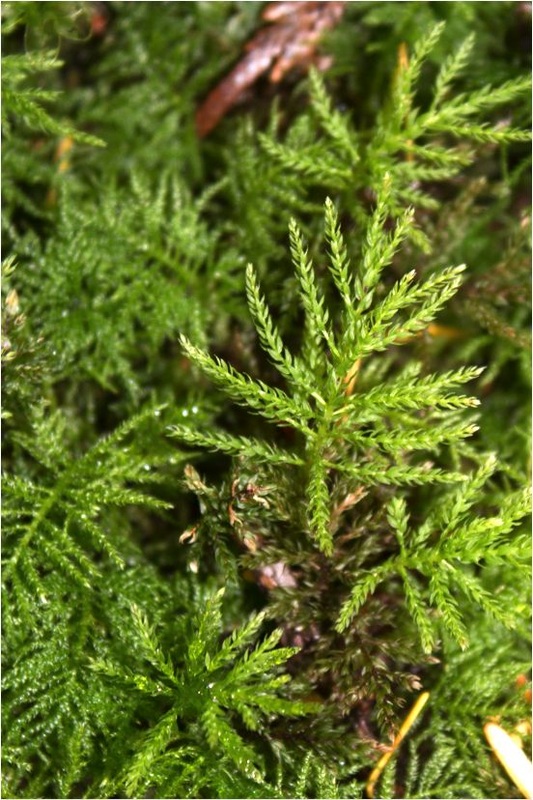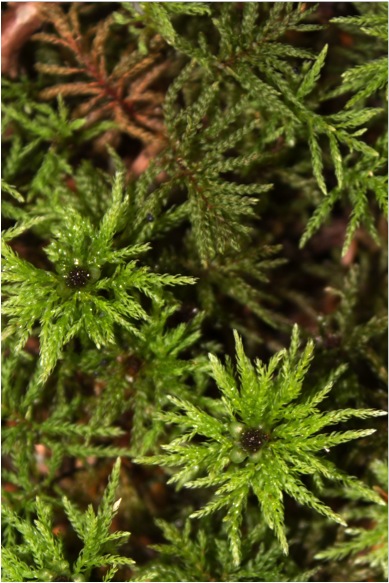Tree moss, tree climacium moss • Climacium dendroides
{dendroides = reference to the tree-like structure of the species}
Identification
This sturdy moss has a distinct tree shape. These 'trees' grow 2-10 cm tall, from branched, horizontal stems. The upright stems (or 'tree-trunks') bear small green filaments, which themselves bear 2.5-3 mm long leaves. The tree-shape of this moss narrows identification down to only a few candidates, but if necessary the leaves can also provide some identifying characteristics. The branch leaves of this species are egg-shaped, toothed, pleated, and have a sharp point. The stem bears similar leaves, though they are flat against the stem, broader, and not pleated. The red-brown sporophytes are uncommon, but may be locally abundant in late winter and early spring. They have long stalks, with upright, cylindrical capsules.
Click here for a more detailed description and some helpful illustrations.
Habitat & Range
Tree moss is most common in moist to wet areas such as humus-rich woods, swamps, the edges of peatlands, and lake edges. It is found from low to subalpine elevations as well as alpine tundra. It is found all along the west coast from Alaska to California, and is widespread but not particularly common. It is also found in areas of northeastern North America and New Zealand.
Similar Species
Menzies' tree moss (Leucolepis acanthoneuron) also has a tree-like appearance. It looks more like a miniature palm tree or umbrella, and the upright stems do not grow from a creeping horizontal stem like tree moss. The stem leaves are whitish, its branch leaves are bordered and more strongly toothed, and its sporophytes are common and nodding.
iNaturalist
https://www.inaturalist.org/taxa/123751-Climacium-dendroides
This sturdy moss has a distinct tree shape. These 'trees' grow 2-10 cm tall, from branched, horizontal stems. The upright stems (or 'tree-trunks') bear small green filaments, which themselves bear 2.5-3 mm long leaves. The tree-shape of this moss narrows identification down to only a few candidates, but if necessary the leaves can also provide some identifying characteristics. The branch leaves of this species are egg-shaped, toothed, pleated, and have a sharp point. The stem bears similar leaves, though they are flat against the stem, broader, and not pleated. The red-brown sporophytes are uncommon, but may be locally abundant in late winter and early spring. They have long stalks, with upright, cylindrical capsules.
Click here for a more detailed description and some helpful illustrations.
Habitat & Range
Tree moss is most common in moist to wet areas such as humus-rich woods, swamps, the edges of peatlands, and lake edges. It is found from low to subalpine elevations as well as alpine tundra. It is found all along the west coast from Alaska to California, and is widespread but not particularly common. It is also found in areas of northeastern North America and New Zealand.
Similar Species
Menzies' tree moss (Leucolepis acanthoneuron) also has a tree-like appearance. It looks more like a miniature palm tree or umbrella, and the upright stems do not grow from a creeping horizontal stem like tree moss. The stem leaves are whitish, its branch leaves are bordered and more strongly toothed, and its sporophytes are common and nodding.
iNaturalist
https://www.inaturalist.org/taxa/123751-Climacium-dendroides
References
Pojar, J. and MacKinnon, A. (1994). Plants of Coastal British Columbia. Vancouver, BC: Lone Pine Publishing. P. 474.
Schofield, W. Climacium dendroides (Hedw.) Web. & Mohr. In Klinkenberg, Brian. (Ed.). E-Flora BC: Electronic Atlas of the Plants of British Columbia. Lab for Advanced Spatial Analysis, Department of Geography, University of British Columbia, Vancouver. Accessed 29/08/2013.
Authors and editors of page
Kelly Fretwell and Brian Starzomski (2013).
Pojar, J. and MacKinnon, A. (1994). Plants of Coastal British Columbia. Vancouver, BC: Lone Pine Publishing. P. 474.
Schofield, W. Climacium dendroides (Hedw.) Web. & Mohr. In Klinkenberg, Brian. (Ed.). E-Flora BC: Electronic Atlas of the Plants of British Columbia. Lab for Advanced Spatial Analysis, Department of Geography, University of British Columbia, Vancouver. Accessed 29/08/2013.
Authors and editors of page
Kelly Fretwell and Brian Starzomski (2013).






